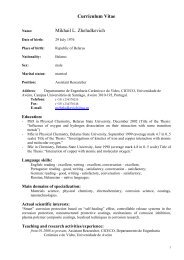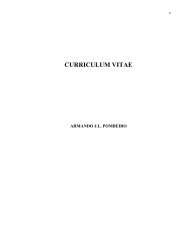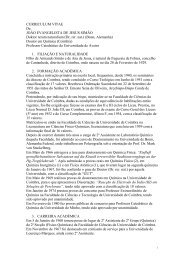XII Iberian Meeting of Electrochemistry XVI Meeting of the ...
XII Iberian Meeting of Electrochemistry XVI Meeting of the ...
XII Iberian Meeting of Electrochemistry XVI Meeting of the ...
Create successful ePaper yourself
Turn your PDF publications into a flip-book with our unique Google optimized e-Paper software.
<strong>XII</strong> <strong>Iberian</strong> <strong>Meeting</strong> <strong>of</strong> <strong>Electrochemistry</strong> & <strong>XVI</strong> <strong>Meeting</strong> <strong>of</strong> <strong>the</strong> Portuguese Electrochemical Society PE 05<br />
Electrochemical studies <strong>of</strong> Cu I -scorpionate complexes<br />
Riccardo Wanke, 2 Luísa M.D.R.S. Martins, 1,2 Armando J.L. Pombeiro 2<br />
1 Área Departamental de Engenharia Química, ISEL, R. Conselheiro Emídio Navarro, 1959-007<br />
Lisboa, Portugal. 2 Centro de Química Estrutural, Complexo I, Instituto Superior Técnico, Av.<br />
Rovisco Pais, 1049-001 Lisboa, Portugal<br />
lmartins@deq.isel.ipl.pt<br />
Metal complexes <strong>of</strong> scorpionate ligands, in particular <strong>of</strong> tris(pyrazolyl)borates (Tp),<br />
constitute one <strong>of</strong> <strong>the</strong> most extensively studied classes in inorganic, organometallic and<br />
bioinorganic chemistries.<br />
The study we now report aimed at <strong>the</strong> syn<strong>the</strong>sis and investigation <strong>of</strong> <strong>the</strong> coordination<br />
ability <strong>of</strong> a new C-scorpionate that could combine flexibility and water solubility with<br />
<strong>the</strong> sterically demanding features <strong>of</strong> <strong>the</strong> 3-substituted tris(pyrazolyl) ligands. For <strong>the</strong>se<br />
purposes, we designed <strong>the</strong> new sterically hindered tris(1-pyrazolyl)methane sulfonate<br />
[SO 3 C(pz Ph ) 3 ] - , (Tpms Ph ) - derivative, bearing a phenyl group at <strong>the</strong> 3-position <strong>of</strong> <strong>the</strong><br />
pyrazolyl rings (Fig. 1). When ligating a metal centre, such a bulky species would be<br />
tion position(s) <strong>of</strong> <strong>the</strong><br />
complex.<br />
A series <strong>of</strong> copper(I) complexes bearing<br />
(Tpms Ph ) - has been prepared 1 and <strong>the</strong><br />
electrochemical behaviour has been studied<br />
by cyclic voltammetry and controlled<br />
potential electrolysis at Pt electrodes,<br />
namely for complexes such as<br />
[Cu(Tpms Ph )(MeCN)] (1) and<br />
[Cu(Tpms Ph )(PTA)] (2) (PTA = 1,3,5-<br />
triaza-7-phosphaadamantane).<br />
Complexes 1 and 2 display an irreversible<br />
process ascribed to <strong>the</strong> Cu(I) to Cu(II)<br />
Fig.1<br />
oxidation.<br />
The electrochemical behaviour <strong>of</strong> <strong>the</strong> above complexes has been interpreted in terms <strong>of</strong><br />
<strong>the</strong> electronic properties <strong>of</strong> <strong>the</strong> ligands and confirms <strong>the</strong> observed 1 solution 1 H-NMR<br />
and solid state X-ray diffraction data. For instance, for 2 <strong>the</strong> higher electron withdrawing<br />
effect <strong>of</strong> <strong>the</strong> ligated phosphine (i.e. PTA) hampers <strong>the</strong> oxidation <strong>of</strong> metal center and<br />
favours <strong>the</strong> N,N,N-coordination mode <strong>of</strong> <strong>the</strong> scorpionate ligand, whereas at 1, Tpms Ph<br />
adopts <strong>the</strong> less electron releasing N,N,O-mode.<br />
Acknowledgements: This work has been partially supported by <strong>the</strong> Foundation for Science and<br />
Technology (F CT), Portugal, and its PPCDT <br />
References<br />
[1] Wanke, R.; Smolénski, P.; Guedes da Silva, M. F. C.; Martins, L. M. D. R. S., Pombeiro, A. J.<br />
L., Inorg. Chem., 2008, 47, 10158.<br />
September, 811, 2010. ISEL - Lisbon 96








